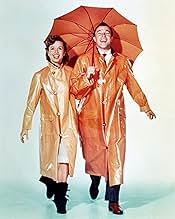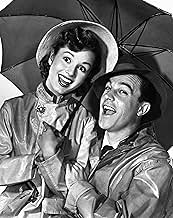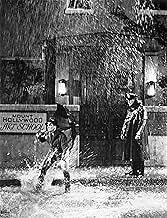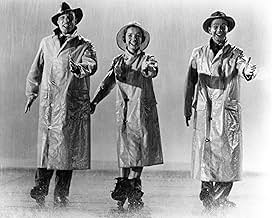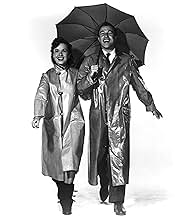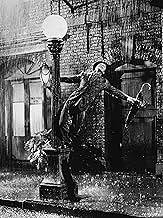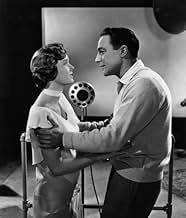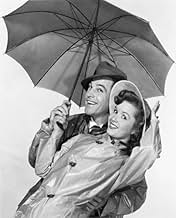Una estrella del cine mudo se enamora de una corista justo cuando él y su compañero de pantalla intentan hacer la difícil transición al cine sonoro en el Hollywood de los años 20.Una estrella del cine mudo se enamora de una corista justo cuando él y su compañero de pantalla intentan hacer la difícil transición al cine sonoro en el Hollywood de los años 20.Una estrella del cine mudo se enamora de una corista justo cuando él y su compañero de pantalla intentan hacer la difícil transición al cine sonoro en el Hollywood de los años 20.
- Nominado para 2 premios Óscar
- 8 premios y 9 nominaciones en total
Dawn Addams
- Teresa - a Lady-in-Waiting
- (sin acreditar)
John Albright
- Call Boy
- (sin acreditar)
Shirlee Allard
- Chorus Girl
- (sin acreditar)
Bebe Allen
- Chorus Girl
- (sin acreditar)
Sue Allen
- Chorus Girl
- (sin acreditar)
John Angelo
- Dancer
- (sin acreditar)
Marie Ardell
- Chorus Girl
- (sin acreditar)
Bette Arlen
- 'Miss January' in 'Beautiful Girl' segment
- (sin acreditar)
David Bair
- Chorus Boy
- (sin acreditar)
Jane Bateman
- Chorus Girl
- (sin acreditar)
Argumento
¿Sabías que...?
- CuriosidadesFor the "Make 'em Laugh" number, Donald O'Connor revived a trick he had done as a young dancer: running up a wall and completing a somersault. The number was so physically taxing that O'Connor ended up in a hospital bed for a week after its completion. He suffered from exhaustion and carpet burns. After an accident ruined all of the initial footage, O'Connor agreed to do the difficult number all over again.
- PifiasDuring the Cyd Charisse nightclub dance number, when she's wrapped around Gene Kelly, her body completely changes position between frames due to a clumsy edit. According to commentary on the special edition DVD, this cut of only a few frames' duration dates back to the original release of the film and no one knows why it exists.
- Citas
Cosmo Brown: Lina. She can't act, she can't sing, she can't dance. A triple threat.
- ConexionesEdited from Los tres mosqueteros (1948)
- Banda sonoraFit as a Fiddle
(1932)
Music by Al Hoffman (uncredited) and Al Goodhart (uncredited)
Lyrics by Arthur Freed
Originally from the 1932 stage revue "George White's Music Hall Varieties"
Sung by Gene Kelly (uncredited) and Donald O'Connor (uncredited)
Reseña destacada
I don't like musicals. They never made any sense to me. Don't get me wrong, I love music; it's an important part of my life. I love movies also, and while the two often compliment each other, sometimes I'm repelled. It's probably the dancing. A person breaking into a complicated dance number, seemingly unaware of their surroundings, or worse yet, in complete synch with a complete stranger is like making fun of the movie, as if to say, "Please don't take us seriously, we like to sing and dance." Or even more ridiculous, "Let's not fight, let's settle this dispute with a song and dance." Forget about suspension of disbelief.
This film however, I manage to enjoy. I once was given the task of my film teacher to watch the film and keep track of all the cuts in the film. Well, sometime after ten minutes I lost track because I was so wrapped up in the story. It really is an interesting period in the history of cinema, told well, and with well placed song and dance numbers that at times drag on, but that seems to be more of an excuse to show off the technicolour than anything else. They build you up to it slowly. The first few numbers don't break out at an inappropriate time. It doesn't last though, but by then they've got you.
With such memorable tunes as these, it's hard to imagine them going wrong. When Gene Kelly sings the title piece, somehow time stands still as you're swept up in one of the most memorable scenes in film history. Just reading the title in print has likely caused you to hum a few bars, or sing a few words. Or maybe, just maybe, walk out without an umbrella when you know it's raining. One thing's for sure, if all Gene Kelly did was choreograph the dance numbers, he more than deserves the co-directing credit he has.
They simply don't make films like this anymore. Which in some ways is a testament to the film's theme and narrative. The business of show is constantly in a state of evolution. The narrative portrays a time period when silent films were being replaced by "talkies" with sound, yet the musical genre itself has almost all but disappeared with the exception of animated films with musical numbers, and rare live-action pieces.
One might speculate that Hollywood overdid the musical. Personally, I can't get into them. Most of the time it seems like a drawn out affair, but this film is something special. Considering my feelings about musicals, it would have to take a film of this one's caliber to make me sit up and take notice.
This film however, I manage to enjoy. I once was given the task of my film teacher to watch the film and keep track of all the cuts in the film. Well, sometime after ten minutes I lost track because I was so wrapped up in the story. It really is an interesting period in the history of cinema, told well, and with well placed song and dance numbers that at times drag on, but that seems to be more of an excuse to show off the technicolour than anything else. They build you up to it slowly. The first few numbers don't break out at an inappropriate time. It doesn't last though, but by then they've got you.
With such memorable tunes as these, it's hard to imagine them going wrong. When Gene Kelly sings the title piece, somehow time stands still as you're swept up in one of the most memorable scenes in film history. Just reading the title in print has likely caused you to hum a few bars, or sing a few words. Or maybe, just maybe, walk out without an umbrella when you know it's raining. One thing's for sure, if all Gene Kelly did was choreograph the dance numbers, he more than deserves the co-directing credit he has.
They simply don't make films like this anymore. Which in some ways is a testament to the film's theme and narrative. The business of show is constantly in a state of evolution. The narrative portrays a time period when silent films were being replaced by "talkies" with sound, yet the musical genre itself has almost all but disappeared with the exception of animated films with musical numbers, and rare live-action pieces.
One might speculate that Hollywood overdid the musical. Personally, I can't get into them. Most of the time it seems like a drawn out affair, but this film is something special. Considering my feelings about musicals, it would have to take a film of this one's caliber to make me sit up and take notice.
- ToldYaSo
- 23 may 1999
- Enlace permanente
Selecciones populares
Inicia sesión para calificar y añadir a tu lista para recibir recomendaciones personalizadas
Detalles
- Fecha de lanzamiento
- País de origen
- Idioma
- Títulos en diferentes países
- Tot cantant sota la pluja
- Localizaciones del rodaje
- Empresa productora
- Ver más compañías en los créditos en IMDbPro
Taquilla
- Presupuesto
- 2.540.800 US$ (estimación)
- Recaudación en Estados Unidos y Canadá
- 1.884.537 US$
- Fin de semana de estreno en EE. UU. y Canadá
- 13.643 US$
- 10 nov 2002
- Recaudación en todo el mundo
- 2.093.659 US$
- Duración1 hora 43 minutos
- Color
- Mezcla de sonido
- Relación de aspecto
- 1.37 : 1
Contribuir a esta página
Sugerir un cambio o añadir el contenido que falta

Principal laguna de datos
By what name was Cantando bajo la lluvia (1952) officially released in India in Hindi?
Responde






